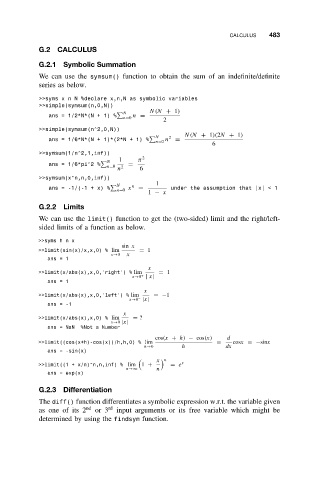Page 494 - Applied Numerical Methods Using MATLAB
P. 494
CALCULUS 483
G.2 CALCULUS
G.2.1 Symbolic Summation
We can use the symsum() function to obtain the sum of an indefinite/definite
series as below.
>>symsxnN %declare x,n,N as symbolic variables
>>simple(symsum(n,0,N))
N N (N + 1)
ans = 1/2*N*(N + 1) % n=0 n =
2
>>simple(symsum(n^2,0,N))
N 2 N (N + 1)(2N + 1)
ans = 1/6*N*(N + 1)*(2*N + 1) % n=0 n =
6
>>symsum(1/n^2,1,inf))
1 π 2
N
ans = 1/6*pi^2 % =
n=0 n 2 6
>>symsum(x^n,n,0,inf))
1
N n
ans = -1/(-1 + x) % x = under the assumption that |x| < 1
n=0 1 − x
G.2.2 Limits
We can use the limit() function to get the (two-sided) limit and the right/left-
sided limits of a function as below.
>>syms h n x
sin x
>>limit(sin(x)/x,x,0) % lim = 1
x→0 x
ans=1
x
>>limit(x/abs(x),x,0,’right’) % lim = 1
x→0 + | x|
ans=1
x
>>limit(x/abs(x),x,0,’left’) % lim =−1
x→0 − |x|
ans=-1
x
>>limit(x/abs(x),x,0) % lim = ?
x→0 |x|
ans = NaN %Not a Number
cos(x + h) − cos(x) d
>>limit((cos(x+h)-cos(x))/h,h,0) % lim = cosx =−sinx
h→0 h dx
ans = -sin(x)
x
n
>>limit((1 + x/n)^n,n,inf) % lim 1 + = e x
n→∞ n
ans = exp(x)
G.2.3 Differentiation
The diff() function differentiates a symbolic expression w.r.t. the variable given
as one of its 2 nd or 3 rd input arguments or its free variable which might be
determined by using the findsym function.

